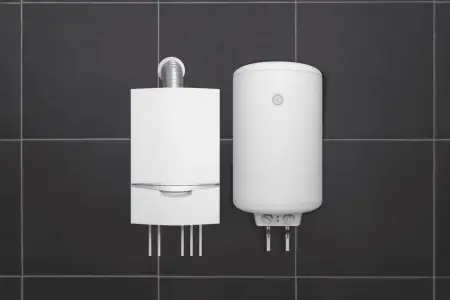A lot of people wonder how long will their water heater will last if it starts leaking.
If it’s the water heater’s tank that is leaking, your heater is already past its due date. You have no choice but to replace it. If you decide to ignore the leak, you’d be lucky to get another week out of the heater. If it’s one of the external pipe joints or valves that are leaking, you could probably have the leak patched up and continue using the heater.
Either way, it’s best to hire a qualified plumber to get the leak plugged as soon as possible – a drip of water today could turn into a torrent next week.
Why Is My Water Heater Leaking?
Following are the leading causes of water heater leaks:
1) Broken or loose drain valves
A heater with broken or loose drain valves will leak from the bottom of the tank. While faulty drain valves cannot be repaired, you (or a plumber) can fix them by installing a new drain valve in their place.
2) Rust and corrosion in the tank
If the water in your area has minerals, it can leave sediments inside the heater. Over time, the sediment buildup can cause rust, cracks and (eventually) holes in the bottom of the tank. Once matters get to this stage, you’d have to replace the heater.
3) Loose water line connections
Any heater’s water line connections can loosen up over time due to normal wear and tear, causing leaks. This issue can be fixed by tightening the connections or replacing the water lines altogether. You’d be able to use the heater after applying the fix.
4) Broken TPR valves
Their name makes it clear what the temperature and pressure valves are all about. Once they break, water leaks might develop on the sides of the water heater tank. You could replace both these valves while keeping the heater.
5) Too much pressure inside the heater
Did you set the water temperature too high? Or perhaps the water was coming into the heater at too high a pressure for its tank. Both these scenarios can build up too much pressure for the heater to handle, resulting in leaks.
What To Do When Your Water Heater Is Leaking?
Here’s what you should do upon noticing your water heater is leaking:
Step 1: Cut the power
One of the first things you should do upon finding a hot water leak is to cut the power supply. Depending on the type of water heater – electric or gas – here’s how you turn off the energy source:
- Gas Water Heater: Find the heater’s thermostat. It’s a little knob with three settings: ON, PILOT and OFF. Setting the knob at PILOT or OFF will cut off the gas supply and make the heater safe to repair.
- Electric Water Heater: Find the breaker supplying electricity to the water heater and shut it off. You need to be fully sure that it’s the right breaker you’ve switched off – touching a leaking heater with electricity running through its wiring can be deadly.
Step 2: Shut off the water supply line
Turn off the cold water line supplying water to your heater. The line should have a valve; turning it to the extreme right will completely shut off the water supply. Wait for a few seconds before moving on to the next step.
Step 3: Drain the water tank
Follow these steps to drain the heater’s water tank:
- Find the drain valve – it will be near the heater’s bottom. Attach a garden hose to the drain valve.
- Run the other end of the hose to a sump pit or floor drain.
- Once you’re sure the hose is in place, open the heater’s drain valve (on older systems, the drain valve may look like a spigot; on newer water heaters, it might be in the form of a drain stem, with a slot for a screwdriver)
- If the water doesn’t flow even after you’ve opened the drain stem, it’s because there’s vacuum inside the heater. You can break the vacuum by opening any hot water fixture in your home. This will allow fresh air to enter the heater and enable the water inside to drain more easily.
- Wait for about an hour – this is the time your heater’s tank might take to fully drain itself.
Step 4: Find where the leak is coming from
Water heater leaks often start at a snail’s pace, just drip by drip, making it difficult to find where the leak is coming from. Check for moisture by running your hand or fingers around these possible locations:
- Pipe fittings above the water heater
- Drain valve close to the bottom of the tank
- The area around the temperature and pressure relief (TPR) valve. Most new heaters have their TPR valve on the side, with a copper tube jutting out of the heater before turning downward. Run your hand against the bottom of the tube (which will be open) to check for wetness.
Step 5: Fix the leak
Depending on where the leak is, here’s how you can fix it:
- If the leak is in the cold water supply line or the hot water pipe, use a wrench to tighten the loose-fitting. This is possible with flex pipes. However, if the water pipes are solid copper, you may have to hire a plumber to have them repaired, as copper pipes require soldering to be sealed.
- If the leak is in the TPR valve, either the water temperature or the pressure inside the tank has reached an unsafe level, forcing the TPR valve to burst open and release excess pressure. You can stop the leak by turning the temperature control knob from “High” to “Medium”. This will reduce both the temperature and the pressure in the tank.
- If the water coming out of the heater isn’t hot, the cold water supply line’s high pressure might be to blame for the leak. Check the water pressure using a pressure test gauge (available on Amazon) and make sure it’s around 80 psi. If it’s around 100 psi, contact your municipal water authority to have the pressure reduced.
- If the leak is in the drain valve, replace it as soon as possible. start by draining the water tank using steps 1 – 3 described above. Next, grip the drain valve using an adjustable wrench. Twist the wrench counterclockwise to take off the valve. Take the removed drain valve to the hardware store, buy a perfect match, and install the new valve by twisting it counterclockwise into the drain valve hole. Keep on twisting until the valve is snug.
- If the leak is at the bottom of the heater’s tank, you may have no other choice but to replace the heater. Hire an expert plumber for the installation of the new unit. Click here for detailed guides on water heaters.
How To Prevent Your Water Heater From Leaking?
Here’s how you can prevent your water heater from leaking:
- Manually test the TPR valve at least once every year to ensure it’s working as intended. A fully-functional TPR valve will let hot water come out of the overflow pipe when you push down or pull up on the valve handle.
- Drain the heater’s tank at least once every 12 to 16 months. This will prevent the build-up of sediments at the bottom of the tank.
- Regularly check all the valves, fittings and water lines connected to your water heater. Make sure there aren’t any signs of water leakage. All the connections should be tight, too.
How To Protect Your Home From Water Damage?
One of the best ways to protect your home from water damage if your water heater starts leaking is to add an automatic shut-off valve to the heater. Upon detecting the leak, the emergency shut off valve will stop the cold water flow to the heater. Keep in mind, though, that these valves don’t come cheap.
A simpler, less expensive method is to install a drain pain under your water heater, before adding a wet switch alarm. Then, once your heater starts leaking, the alarm will give off a loud noise, alerting you to shut off the cold water supply line.

I graduated with a degree in Chemical Engineering and have written for a number of nationally recognized publications in the home improvement space. My skills include fluid mechanics and process engineering and I have worked on numerous projects, including in waste water flow rate calculation and heat balance of steam rollers in the paper industry. My goal as a technical writer is to make complicated topics easy to understand for the average person.
